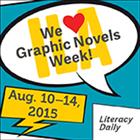 My library’s copies of Raina Telgemeier’s books are never on the shelf. They fall apart from repeated circulation, even when we have them in hardcover. Our kid readers just can’t get enough of Telgemeier’s funny, thoughtful, painfully real graphic novels. And they aren’t alone. As of the week of August 2, 2015, Smile, her autobiographical graphic novel about the year she suffered through orthodontic traumas, has been on The New York Times Best Seller List for a whopping 162 weeks (that’s a list that encompasses adult titles too!). Her other books are also permanent residents of the list—with Drama clocking in at 103 weeks and Sisters, her new title, at 43 weeks. That is a rare and special kind of intense, sustained interest—the kind that mean kids have a deep love for Raina Telgemeier’s work.
My library’s copies of Raina Telgemeier’s books are never on the shelf. They fall apart from repeated circulation, even when we have them in hardcover. Our kid readers just can’t get enough of Telgemeier’s funny, thoughtful, painfully real graphic novels. And they aren’t alone. As of the week of August 2, 2015, Smile, her autobiographical graphic novel about the year she suffered through orthodontic traumas, has been on The New York Times Best Seller List for a whopping 162 weeks (that’s a list that encompasses adult titles too!). Her other books are also permanent residents of the list—with Drama clocking in at 103 weeks and Sisters, her new title, at 43 weeks. That is a rare and special kind of intense, sustained interest—the kind that mean kids have a deep love for Raina Telgemeier’s work.
But what to do when your readers have finished all of Telgemeier’s books? Deep love is a great chance to hook readers, so you don’t want to lose the kids that want more reads like Telgemeier’s. Here are some of my favorite read-alikes for Raina’s wonderful work.
When recommending read-alikes for Raina Telgemeier, I choose graphic novels that tell realistic stories about personal lives, school adventures, and family ties. I try to avoid work with fantasy or sci-fi elements (unless a reader indicates an openness to the addition of this content) to more closely match the content of Smile, Drama,and Sisters. Here are a few favorites to expand your graphic novel collection and keep your fans reading. These books are all in print as of August 2015 and are recommended, in general, for readers ages 8–12.
Akissi: Feline Invasion. Marguerite Abouet. Ill. Mathieu Sapin. 2013. Flying Eye Books.
Nothing stops Akissi: She’s funny, clever, and determined. Meet her family and follow along on her daily adventures through her bustling West African town in this read-alike translated from French.
Awkward. Svetlana Chmakova. 2015. Yen Press.
Peppi just wants to fit in at middle school, but it’s harder than she imagined. When her art club starts to clash with her enemy Jaime’s science club, can they find a way to move past the awkwardness?
Chiggers. Hope Larson. 2008. Antheum Books for Young Readers.
This summer at camp everything is going wrong for Abby—none of her friends seem the same and the only girl she seems to get along with is the new girl, Shasta.
El Deafo. CeCe Bell. 2014. Harry N. Abrams.
CeCe is deaf but she hates being “special.” El Deafo follows her amazing journey of finding the superpowers and regular resilience within herself.
 Luz Sees the Light. Claudia Davila. 2011. Kids Can Press.
Luz Sees the Light. Claudia Davila. 2011. Kids Can Press.
Inspired by the energy shortages in her neighborhood, Luz works with her friends to make their neighborhood more self-sustaining in this first book in The Future According to Luz series.
Page by Paige. Laura Lee Gulledge. 2011. Amulet Paperbacks.
Paige has just moved to New York City, and she uses her sketchbook as her safe space to explore her new surroundings and develop her skills as an artist.
Play Ball. Nunzio DeFilippis and Christina Weir. Ill. Jackie Lewis. 2012. Oni Press.
Dashiell can’t believe her luck when she finds out her new school has a great baseball team. She decides she’s going to join them, no matter who says girls can’t play.
Roller Girl. Victoria Jamieson. 2015. Dial Books.
12-year-old Astrid gains self-confidence, fails some, and learns about herself, her friends, and her life as she falls in love with the sport of roller derby.
Secret Diary (Lou!). Julien Neel. 2013. Graphic Universe.
Translated from French, this series follows Lou, a 12-year-old who confides all her secrets to her diary. She crushes on boys, creates her own clothes, and tries to navigate middle school.
Sunny Side Up. Jennifer L. Holm and Matthew Holm. Coming 8/25/2015. Scholastic.
Sunny is spending the summer with her Grandpa in Florida and falling in love with comic books. But her life isn’t as sunny as it looks at first.
This One Summer. Mariko Tamaki. Ill. Jillian Tamaki. 2014. First Second.
Rose and Windy usually spend their summers having fun, but things are getting harder as they get older. This one summer, the girls will have to rely on their friendship to get them through.
And hopefully many other titles will follow Raina Telgemeier’s winning formula of appealing to tween readers by telling the truth about their lives in engaging, funny, and immediately relatable narratives. Librarians and teachers join the call of our young students and patrons: More, more, more—we want more!
Angie Manfredi is the head of Youth Services for the Los Alamos County Library System in Los Alamos, NM. She’s been reading comics faithfully since her beloved Archie comics in the fourth grade and is dedicated to literacy, education, and every kid’s right to read what they want. You can read more of her writing at www.fatgirlreading.com or find her on Twitter.